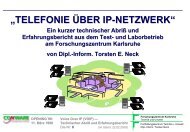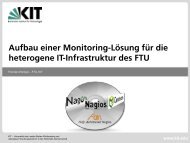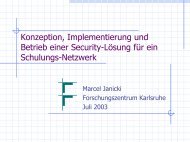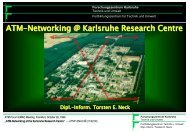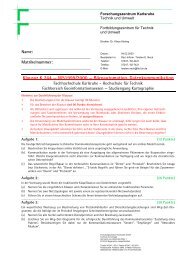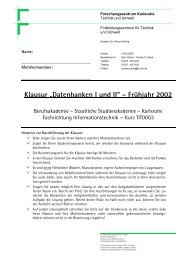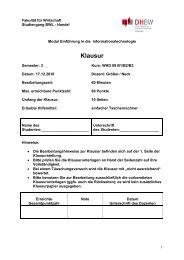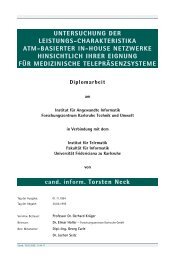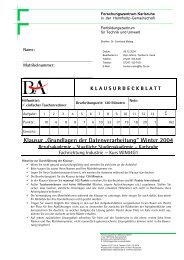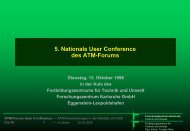Interner Brief - Torsten E. Neck
Interner Brief - Torsten E. Neck
Interner Brief - Torsten E. Neck
Create successful ePaper yourself
Turn your PDF publications into a flip-book with our unique Google optimized e-Paper software.
Forschungszentrum Karlsruhe<br />
Technik und Umwelt<br />
Institut für Angewandte Informatik<br />
Leiter: Prof. Dr.-Ing. G. Bretthauer<br />
Datum: 19.02.08<br />
Bearbeiter/-in: Dipl.-Inform. <strong>Torsten</strong> E. <strong>Neck</strong><br />
TESUS I Additional Report<br />
for Partner C3, Institute for Applied Informatics,<br />
Research Centre Karlsruhe<br />
1 Remarks to the first report dated January 19, 1998<br />
At the begining we want to state that all the work carried out in the TESUS I project by the<br />
Institute for Applied Informatics as it was described in the report dated January 19, 1998, is<br />
fully compatible to the program definition. The concerns of the project board especially about<br />
the interactive teleconsultation scenarios driven by a proprietary serial line protocol via ISDN<br />
or via the standard protocol SNMP cannot be accepted, as the original TESUS description of<br />
WP07 says: "WP07 will define the specifications for enhanced services in the following<br />
TESUS 1 concepts: Teletraining, Hot-line and Duty. All of these aspects are of course to be<br />
understood on-line. The need for transmission of high quality video and distant interaction<br />
with the images will appear mandatory ..." The term "enhanced services" implies a valueadded<br />
service for the mentioned "Teletraining" and "Hotline" which definitely leads to the<br />
needs of implementing a control component at least for the main surgical information source,<br />
the endoscopic view. Furthermore we do not accept any concerns about the work having<br />
already been started, as the TESUS 1 program explicitly tells: "The engineers will have<br />
started theri technical specifications approach for WP07 before timing ..." Thus the work<br />
carried out by partner C3 is to be understood as one approach which has to be discussed<br />
within the WP07. There is no doubt about the complience neither of our topic F — VR based<br />
surgical training service — with the program description of WP07, nor of our topics C, D, and<br />
E with the specification of WP10. Unfortunately the technical partners were not granted to get<br />
a visioconferencing system at a special price, so to carry out the works for TESUS 1 it was<br />
mandatory to get a system of our own, which is suitable for the work in the advanced<br />
workpackages 07 to 10.<br />
We want to emphasize that the work described in the above mentioned report was not yet<br />
included into our cost statement dated August 22, 1997. Unfortunately up to now the<br />
workpackages 07 to 10 which solely include any work of partner C3 have not been started,<br />
thus all the work carried out under the aspects of these workpackages has been done in<br />
advance at our own costs at the moment.<br />
We furthermore want to state, that we are not included in any other projects that contribute<br />
financially to the work described in our former report.<br />
This report in addition to the overall report of partner C3 dated January 19, 1998 is dedicated<br />
to the WP04, multiconferencing platform. It does not replace any work described in the<br />
former report but wants to distribute additional ideas in the field of this specific workpackage<br />
on multiconferencing.<br />
Forschungszentrum Karlsruhe GmbH<br />
Technik und Umwelt<br />
Hermann-von-Helmholtz-Platz 1<br />
D-76344 Eggenstein-Leopoldshafen<br />
Telefon 07247 / 82-0, bei Durchwahl 82<br />
Telefax 07247 / 82 5070<br />
Postanschrift: Postfach 3640, D-76021 Karlsruhe<br />
Stadtadresse: Weberstraße 5, D-76133 Karlsruhe
2 Technical principals of the multi-point conference<br />
Point-to-multipoint visioconferences (abbreviated P2M in further) are quite similar to point-topoint<br />
(P2P) conferences. In fact they use the same end-systems as P2P. Thus all the<br />
recommendations and rules given for P2P systems are still valid for P2M systems, P2M can<br />
be seen as a natural evolution from the P2P technique by adding a single piece of valueadded<br />
hardware. As stated before, P2M technique only needs one additional hardware<br />
called 'MCU', multiconferencing unit.<br />
A MCU concentrates as many ISDN lines as needed to connect to each P2M partner with the<br />
appropriate bitrate. MCUs usually are scalable or they can be cascaded to extend the<br />
number of concurrently served partners. The scalability usually is independent from the<br />
number of available ISDN links. This means that it is possible to run for example a 16 party<br />
MCU on an ISDN PRI thus allowing the P2M interconnection of five partners at a quality of<br />
384 kbps or 15 partners at a quality of 128 kbps.<br />
A MCU in principle runs two functions:<br />
• it does set-up a P2P connection to each partner concurrently<br />
• it distributes the sound and video streams of one participant (who currently has got the<br />
focus) to all other participants.<br />
In consequence of that basic functionality P2M technique differently from P2P needs a<br />
session management to switch the focus among the communicating partners, which is<br />
provided by the MCU, too. The MCU therefor defines two tokens which represent two<br />
classes of rights granted to a partner, the first token stands for the focus in sound, the<br />
second token stands for the focus in video. Thus it is possible to deliver a common video<br />
stream concurrently to all participants derived from one partner but to have the audible<br />
comments on the video derived from a different partner and distributed to all other partners.<br />
Mainly there are two principals of managing these tokens:<br />
• an automatic token passing controlled by sound: both tokens are put to the partner who<br />
at last produced some sound at his site. This principle is excellent for controvers<br />
discussion among a small number of participants because there is no need of a<br />
dedicated session leader, but it needs a very good discipline at all partners, who are not<br />
allowed to produce any noise like snorring our shouts while another partner is speaking.<br />
• A manual token passing controlled by a session manager, who can pass the tokens<br />
indepentently to any partner.<br />
MCUs can be installed at one site in a consortium of frequently communicating partners (like<br />
in the TESUS network), but it is also possible to use a MCU in form of a service provided by<br />
a public carrier. The hardware in the latter case is out-sourced to the carriers location and the<br />
participants call at a special service line or they are called by the MCU. The session<br />
management, if not done in automatic mode, can be passed to one of the partners.<br />
As the endsystems in a P2M conference are the same systems which are deployed for P2P<br />
visioconferences there are still the same possiblities to connect audio-visual sources. If the<br />
end-system itself is not capable of connecting different sources directly, an analogue video<br />
switch (cross-bar) and an analogue audio mixer can be used as a multiplexer for different<br />
independent sources. Usually these cross-bars and mixers are remotelyx controllable via<br />
serial lines or TCP connections, which may allow every partner to interact with these devices.



